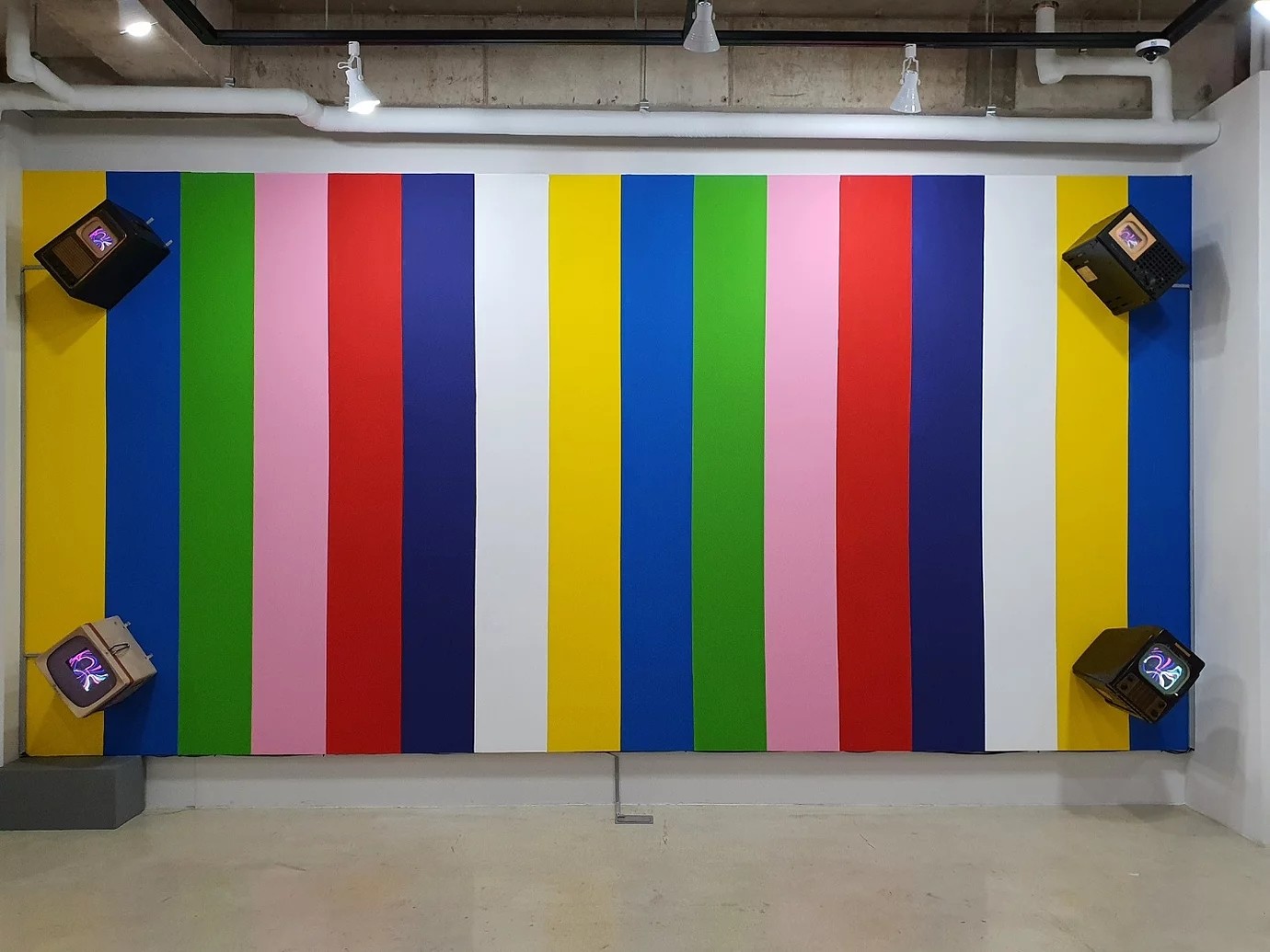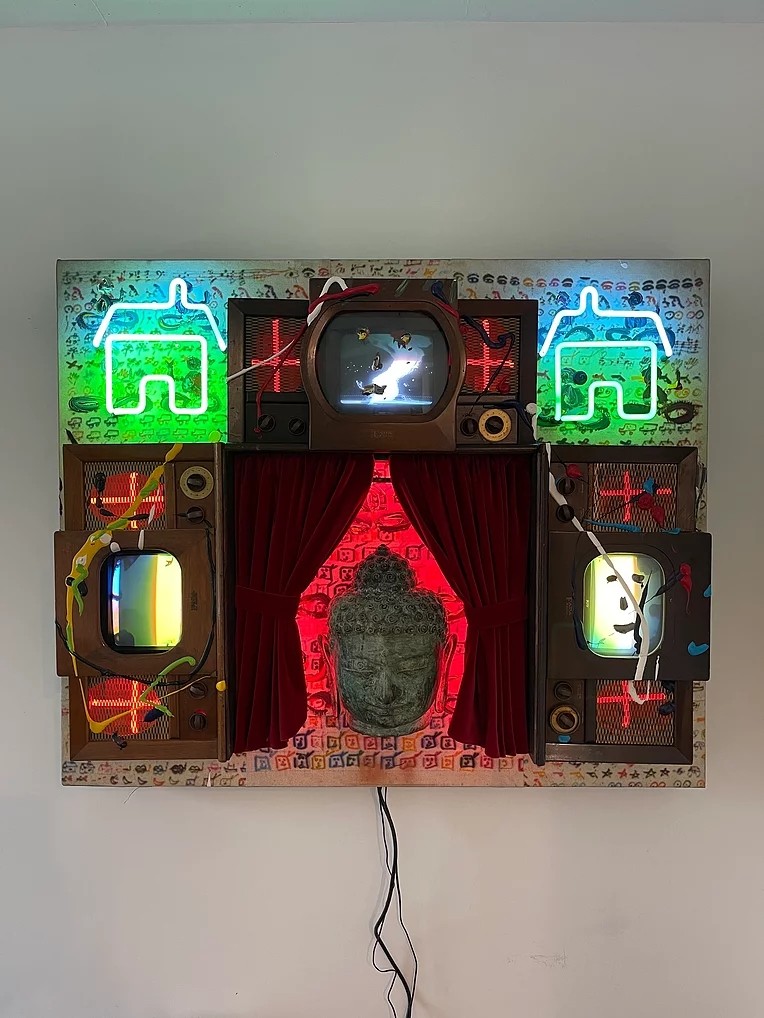
Nam June Paik, DO NOT WATCH TV, Nam June Paik Bronze Dead Mask, Vacuum Tube, Antique TV, Book (Tom Swift and His Giant Robot) 82 x 54 x 82 cm, 1990
Tang Contemporary Art will present the internationally renowned artist Nam June Paik in its Hong Kong space from September 24th to October 16th, 2021.
The founder and pioneer of video art, Nam June Paik—a cosmopolitan who was born in Seoul and made his home in the East as well as the West through Hong Kong, Japan, and Germany until his death in the United States—drew a future where humans, technology, and nature could be in perfect harmony. Confronting the gloom of the mass media oppressing and controlling humanity, he presented a world where technology and humans coexist, and contrary to a line from Kipling’s poem, “East is East and West is West, and never the twain shall meet,” he worked by connecting the United States, Korea, and Japan via satellite. The artist predicted that the East and the West would be joined through media and that people around the world would communicate with one another in real time.

Nam June Paik, Neon TV - Dish=Antenna, Mixed media
60 x 60 x 25 cm, 1990
Paik studied aesthetics as well as music and art history at the University of Tokyo before moving to Germany, where he started to gain fame as the “Destruction Artist” in his avant-garde experimental performance from 1959. During that span, he also presented a sensational performance with Joseph Beuys, and their deep friendship can be seen in his work Beuys Vox. Paik then took a step further from destructive art and attempted to visualize sounds. His first solo exhibition Exposition of Music - Electronic Television was held at Galeire Parnass on March 11, 1963. It was the first video exhibition in history, thus making him the founder of video art. He then would induce active interaction between his works and the audience by rejecting the one-sided transmission system of television and transforming the screen with the help of voices in the audience. This action contained his philosophy that art without communication is just another form of dictatorship.

Nam June Paik, I Never Read Wittgenstein, Wall painting in seven colors with four Televisions TV Box
size: 50 x 60 x 50 cm x 4 1999
As such, video art begins with the spirit of resistance to dismantle the informational dominance of television and to overcome the social pathology it causes. As a member of the international avant-garde Fluxus movement, Paik approached video art with the anarchist thinking and anti-aesthetic philosophy advocated by Fluxus. His seeking for anti-aesthetics was aimed at making audience participation the subject of art and rejecting isolation from the public through communication. This idea can be found in his work I Never Read Wittgenstein. With seven colors reminiscent of a TV test pattern, the work contains his intention to communicate through art. Opposing Wittgenstein’s proposition, “What we cannot speak about we must pass over in silence,” Paik argues that what cannot be uttered can be portrayed through art.

Nam June Paik, Video Chandelier X, Mixed media Ø 130 x 120 cm, 1991
The artist took an optimistic view of the impact science and technology would have on future works, saying, “As [the] collage technique replaced oil paint, the cathode-ray tube will replace the canvas.” His philosophy that technological advancement can be brought into the realm of art is well expressed in Video Chandelier X and Sonatine for Goldfish. The former consists of 11 small monitors installed on the ceiling in the form of a chandelier. In this work— where cables and monitors are covered with plants—humans, nature, and technology are in harmony. Sonatine for Goldfish also signifies the coexistence of nature and artificiality. The perfect fusion of the two elements, technology and nature, can be seen in this video object: a goldfish, a symbol of nature, swims in a television, a symbol of technology.

Nam June Paik, Homeless Buddha, Single channel video sculpture
(three antique television cabinets, three 13-inch color monitors, neon, bronze, velvet curtain, Paik Laser disc, laser disc player)
123 x 151 x 37cm, 1991
Other similar combinatory works include Homeless Buddha and Digital Painting. By staging religion and technology together, Paik completed the face-to-face encounter of both spiritual and material culture. Unlike this fusion with religion, Before the Word There was Light, After the Word There Will be Light shows the artist himself referring to religion by parodying Genesis and the Gospel of John. Using a television monitor showing a candle as an extended object, this work recreates the piece he made in 1948 as a comparison to his video art “in the beginning.” His intent is to show that video art (light) runs through the past and the future more visually than any word and at the same time becomes a medium of art and communication.

Nam June Paik, French Clock TV, 4 monitor sets (Panasonic), clock, video camera on tripod
170 x 140 x 200 cm, 1989
French Clock TV, which uses the moon as its subject, visualizes time. This work, where the movement of a clock pendulum in the shape of the moon expresses the heavenly body’s trajectory, is an installation of closed-circuit televisions in which the image captured by a video camera is converted to a monitor through a cable. As Paik said, “In video, space functions as time,” so this installation displays the continuity of electrons that constantly move image information through cables on the monitor. Accordingly, the audience can sensibly experience the flow of time as visualized through this work.

Nam June Paik, Self-portrait, 1950's Philco Predicta television cabinet with mixed media
59.5 x 62 x 37 cm, 1989
Self-Portrait is a collection of Paik’s philosophy and past and is full of various objects that form motifs, such as a bronze mask with his face, a Buddha statue, a piano, a clock, and the like on a TV. This is a significant work that represents his own artistic world and achievements, now filled with the objects that symbolize his philosophy and thought, while in the past he started by dismantling and emptying television.
Video is not a ready-made art, but an art of ready-made representation and reproduction. Paik opened a new chapter in art like Marcel Duchamp, who started the whole concept of ready-made works. He transformed the cold attributes of a machine into something warm based on his own philosophy. Nam June Paik, who made various attempts to break new ground, is one of the most provocative and innovative artists since the 1960s and is highly revered by most critics, and his works and ideas, including video sculptures, installations, and performances, inspire many media artists to this day. This exhibition will hopefully become a part of what art is by providing an opportunity to communicate with Nam June Paik’s works that most contain his philosophy.
About the exhibition
Curator: Yonni Park
Dates: 9.24 - 10.16, 2021
Venue: Tang Contemporary Art, Hong Kong - H Queen's
Courtesy Tang Contemporary Art.




























